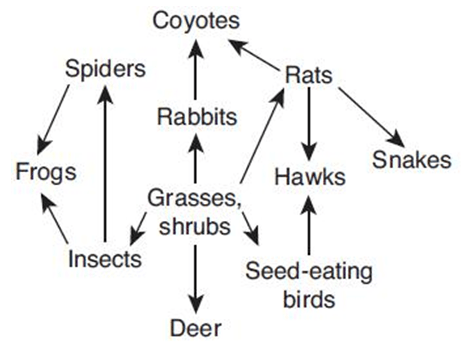All living factors in an ecosystem.
Biotic Factors
 What organism(s) represent the largest trophic level?
What organism(s) represent the largest trophic level?
Grasses, shrubs
What do the arrows in a food chain or food web represent?
Arrows represent how the energy is being transferred (who is eating who)
A symbiotic relationship that involves species having to fight for something they both need or want
competition
In an ecosystem, producers like plants provide resources for consumers. What else do producers supply to consumers besides energy?
A. Water and minerals
B. Light and sound
C. Oxygen and carbon
D. Soil and nutrients
C. Oxygen and carbon
All of the living things interacting with the nonliving aspects of the environment.
An ecosystem
In an energy pyramid, what is the proper name for ANY organism above the producer level?
Consumer
Name a predator-prey relationship
coyote - rabbit; spider - insect; hawks - seed eating birds
Mistletoe extracts water and nutrients from the spruce tree to the detriment of the spruce. What kind of relationship is this?
Parasitism
A gas produced by plants during photosynthesis that animals use for respiration. What is the gas and what cycle is it part of?
Oxygen; Carbon/Oxygen Cycle
A place where a plant or animal lives
Habitat
Only 10% of the energy available at each trophic level moves on to the next level. 90% is used by the organism or dissipated as _______________.
heat
Which of the following organisms has the most energy?
algae → krill → fish → seal
A. krill
B. seal
C. fish
D. algae
D. algae
When a mosquito bites you, you are the ___________ and the mosquito is the _____________ .
Host; Parasite
In the carbon cycle, carbon is transferred from animals to plants by which of the following:
A. carbon dioxide
B. oxygen
C. sugars
D. water
A. carbon dioxide
Interacting population of various kinds of individuals (as species) in a common location.
Community
What might happen if you remove a primary consumer from the ecosystem?
The number of plants would increase.

What might happen to the rabbit, insect, and seed-eating birds if grasses and shrubs were removed from the ecosystem?
The Herbivore populations would decrease.
The maximum amount of organisms that can survive in an ecosystem.
Carrying Capacity
Which correctly describes an event in the carbon cycle?
A. Animals take in carbon through respiration.
B. Plants release carbon through photosynthesis.
C. Plants and animals release carbon through decomposition.
D. Plants and animals take in carbon through combustion
C. Plants and animals release carbon through decomposition.
Rocks, Water, and Sunlight are examples of this type of factor.
Abiotic
Phytoplankton get their energy are _________________ and get their energy from ____________________.
producers; the sun
An organism that lives by breaking apart dead organic matter into simpler parts is
decomposer
Red-billed oxpeckers are birds that feed on parasites found on a impala. This is an example of what type of relationship?
Mutualism
Which of these is a role of plants in the carbon cycle?
A. Plants take in oxygen and release carbon dioxide.
B. Plants take in carbon dioxide and pass it directly to animals.
C. Plants take in carbon dioxide released by other organisms.
D. Plants use carbon dioxide to make nitrates.
Plants take in carbon dioxide released by other organisms.